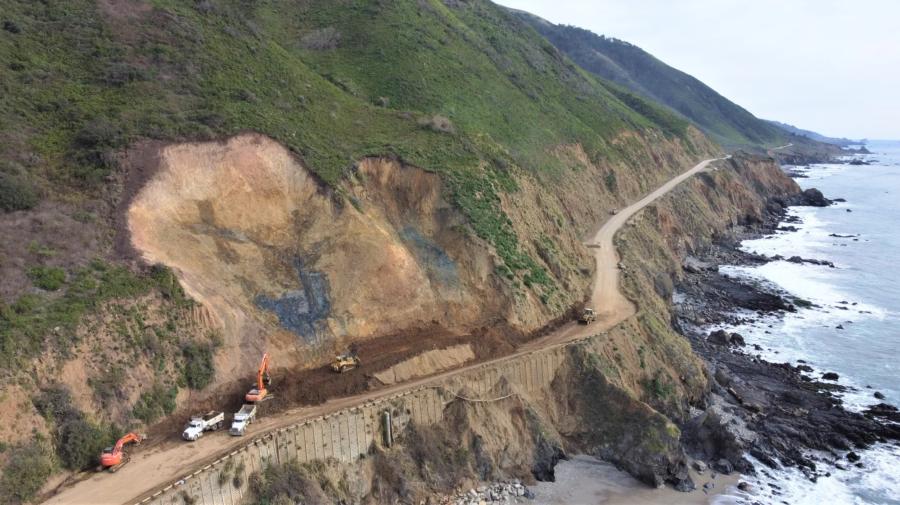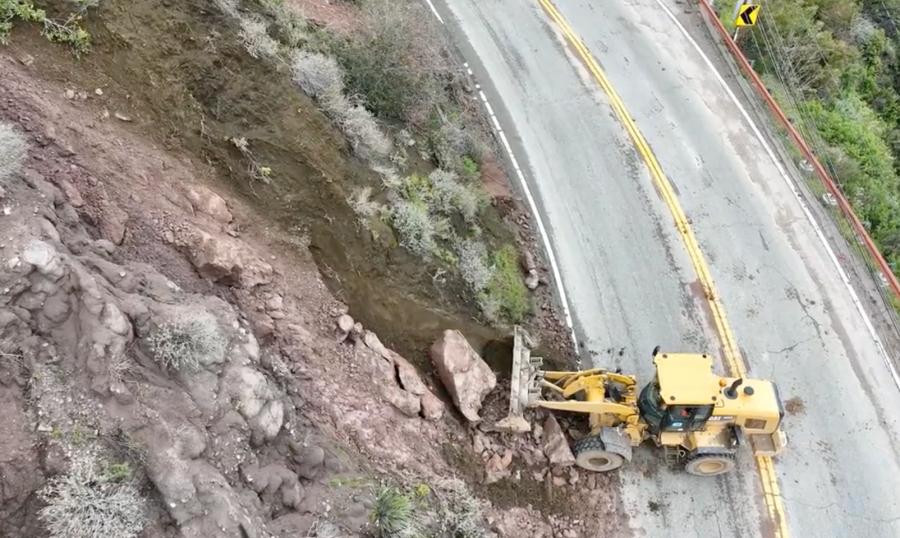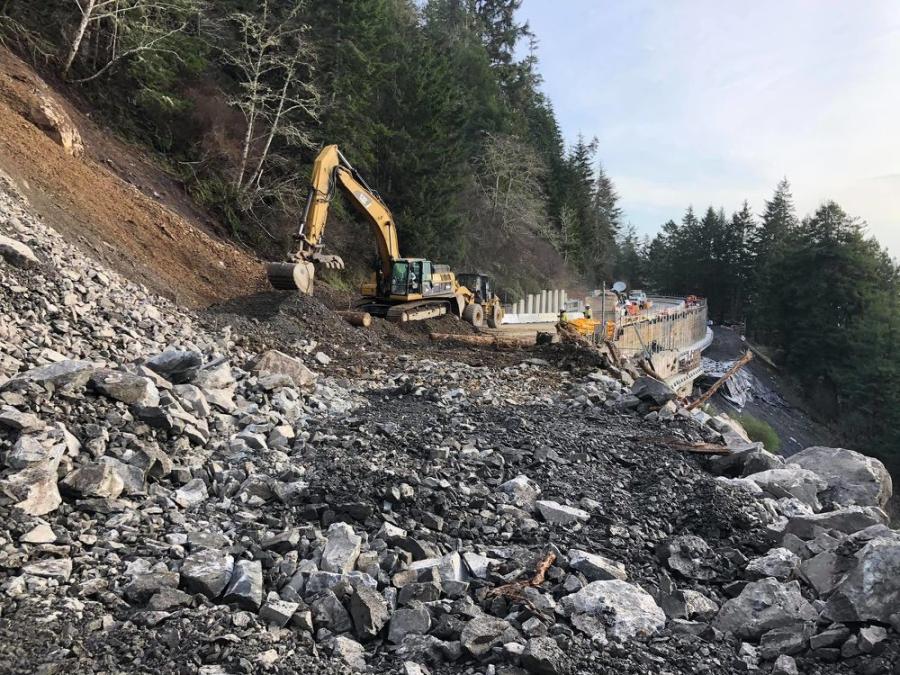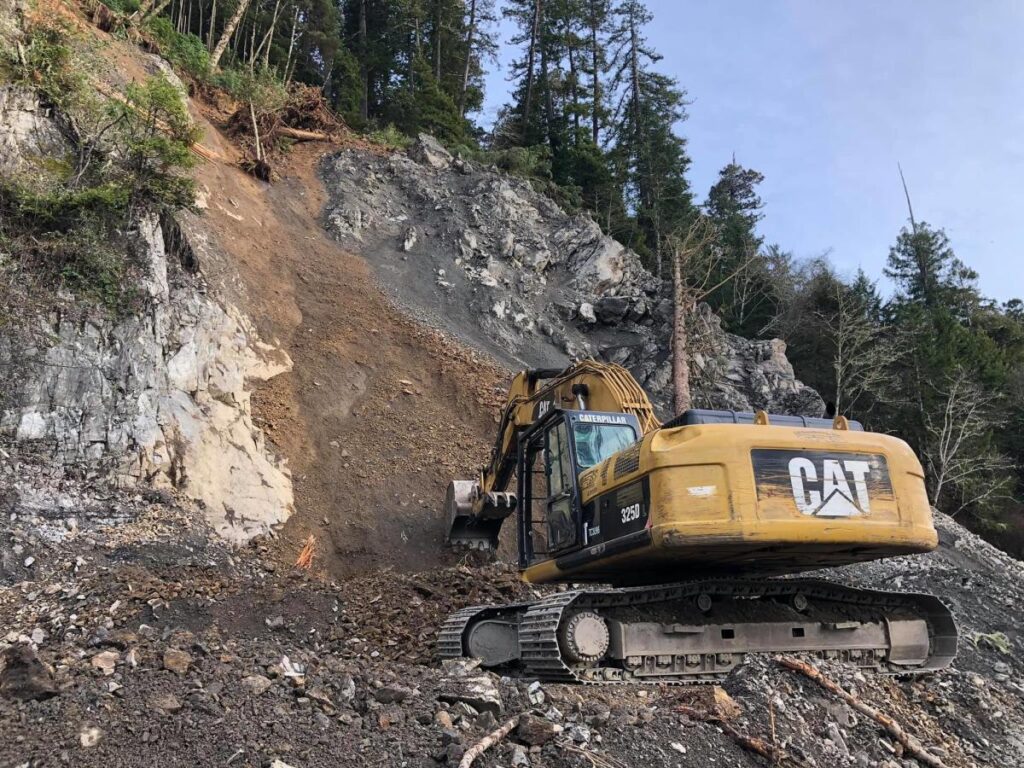Photo courtesy of Caltrans
Landslides are causing havoc throughout the state, including on Big Sur where a 7 ft. section of roadway collapsed and has closed the famed highway indefinitely for 40 mi. Local residents needed convoys of food and other vital supplies.
A landslide on Highway 1 (The Pacific Coast Highway) led to an approximately 7-ft. section of the outer lane sliding down the hillside and the indefinite closure of the famed highway in Big Sur for 40 mi., which leaves only one functional lane open based on convoys overseen by the California Department of Transportation (Caltrans) and law enforcement authorities to ensure a safe passage for motorists. The landslide was caused by heavy rains.
“Another section of California’s Highway 1 has collapsed days after Caltrans announced it was getting closer to its promised reopening of the scenic roadway in the wake of destructive landslides brought on by stormy weather,” Caltrans said.

Photo courtesy of Caltrans
The DOT has been on top of the situation since the section collapsed. Emergency crews and engineers have been on-site assessing the damage, state of the highway in the immediate area and sorting out the traffic situation, which initially left more than 1,600 motorists stranded overnight.
“Activities following this incident included the addition of gravel to the drainage ditch off the shoulder of the northbound lane to ensure proper drainage through the site,” stated Caltrans. “Work was also completed to pave over a gravel-filled ditch and part of the dirt shoulder of the northbound lane to gain extra room in the travel lane. Caltrans is continuing to focus on repair strategies to stabilize the edge of the roadway with details of this operation, work hours and timetable to be announced when details are certain.”
The installation of a barrier to protect highway workers and temporary re-striping to accommodate equipment expected to be mobilized to this area was completed the weekend of April 5.
“Additionally, emergency responses through the closure area are complicated by the presence of heavy machinery staged in the northbound lane, which could take up to an hour to remove,” Caltrans said.
Caltrans officials responded rapidly and by the morning of March 31 DOT engineers completed their assessments, confirming that motorists could drive on the northbound lanes under close supervision. Convoys began on noon that day.
Jim Shivers, Caltrans District 5 public-legislative affairs manager, provided the latest news on the Rocky Creek landslide and overall situation of Highway 1.
“This repair process will include drilling into the rocks in the area below the highway,” he said. “This will take place on the sheer cliff wall below the highway. There is no estimate at this time [when this section will reopen].”
Asked to what extent are there concerns about sections of the road immediately north and south of the landslide, Shivers replied, “We are continuing to monitor all areas and there has been no change in the footprint of the slip out or impacts to the surrounding highway from when it initially occurred.”
Caltrans is leaving no stone unturned to ensure the viability of Highway 1’s infrastructure and the safety of motorists.

Photo courtesy of Caltrans
“Each incident is different and we respond accordingly,” said Shivers. “We have various things in the toolbox for each location. At each repair site, we have been able to install modern drainage facilities to increase the amount of water we can keep away from nearby slopes and the highway.”
He added that Caltrans has not identified any other section of the highway where landslides could occur.
Caltrans and local emergency personnel arrived on-site rapidly after they were informed of the Rocky Creek landslide.
“The most important thing is to keep the public safe by implementing the closure and convoys,” Shivers. “It is also important to monitor conditions so that we can allow our highway workers to be in the safest environment possible.”
As has been pointed out, Caltrans is aware of the possibility of landslides and has well-honed response plans.
“We have been consistent in our approach,” said Shivers. “We have improved our outreach by briefing the business community and elected officials. We have a robust social media presence where constant updates are posted.”
“We want to emphasize that this is a state jurisdiction disaster,” Nicholas Pasculli, the director of communications for Monterey County, told SFGATE. “The key now is for people who don’t belong down there to stay away from that area. We don’t need any more traffic along that stretch of the road.”
Timeline of Events
Landslides in February closed 10 mi. of Highway 1 near Big Sur, which also led to convoys for local residents to secure food and other vital supplies. Last year, Caltrans removed close to 500,000 cu. yds. of debris due to a landslide, which occurred in January.
Over the past few months, Highway 1 was impacted by serious atmospheric river storms, as were roads in the interior.
Prior to the March 30 landslide, crews were conducting road repairs at Paul’s Slide, Post Mile 22; Regent’s Slide at Post Mile 27.78; and Dolan Point at Post Mile 29.5. At Dolan Point, a permanent cable net system will be installed on the face of the slope.
According to the SGATE, the majority of Highway 1 was open “save for a 12.1-mile section between the Esalen Institute at the north end and just south of Limekiln State Park, part of the same area affected by the recent slide.”
The Caltrans convoy system is working well.
“[March 31], we likely did have the highest volume of people come through who needed to take advantage of convoys,” Kevin Drabinski, a Caltrans public information officer told SFGATE. “A lot of those people were on the other side of a closure in a way they had not planned for. I can imagine two scenarios: people who came down to Big Sur for the day and found themselves having to stay overnight and people who may have been staying in Big Sur and took a day trip up to Monterey and were unable to return.”

Photo courtesy of Caltrans
Daily convoys resumed on April 6 through the site of the Rocky Creek Slip Out, approximately 17 mi. south of Monterey, at 8 a.m. and again at 4 p.m. based on final assessments by Caltrans engineers. On Tues., April 9, the convoy times changed to 7 a.m. and 5 p.m. after consultations with community stakeholders and in collaboration with the Monterey County Department of Emergency Management.
“Caltrans engineers and maintenance staff continue to monitor the site for any significant changes and the public will be advised of any modifications to this schedule,” stated an April 5 press release from Caltrans District 5 (Santa Barbara, San Luis Obispo, Monterey, San Benito and Santa Cruz counties).
A slip-out near the Rocky Creek Bridge, less than 1 mi. from Bixby Bridge, caused chunks of asphalt from the southbound lane of the highway to plummet into the ocean below, stranding some tourists in the area, authorities with the California Highway Patrol said. A roughly 40-mi. stretch of the road has been closed in both directions, from Palo Colorado Road (Post Mile 61.5) to just south of Limekiln State Park (Post Mile 32.1) and Caltrans engineers are currently assessing the site.”
As the situation remains fluid, Caltrans noted that “updates on the status of the closure of Highway 1 at the Rocky Creek Bridge will be provided as more information becomes available.”
An April 9 Caltrans press release provided a more detailed explanation on its convoy system, especially in relation to efforts to repair the affected section.
“Convoys are intended for the use of local residents and essential workers only,” it stated. “Limiting the volume of vehicles through the repair site is one strategy which is helping manage the risks associated with conditions at the slip out and with emergency response. Public safety personnel have been consistent in their support for limiting convoys to residents and essential workers. There are limited public safety resources staged south of the closure area.”
Noted the SFGATE: “Pasculli said the response to the washout has been ‘an all-out community effort,’ with at least seven hotels, bed and breakfasts and campgrounds racing to offer up their amenities to people who were trapped. A temporary evacuation shelter set up at Big Sur Lodge was at about 75 percent capacity,” he said, “and some people ultimately chose to stay in their vehicles overnight.” CEG
Read the full article here











